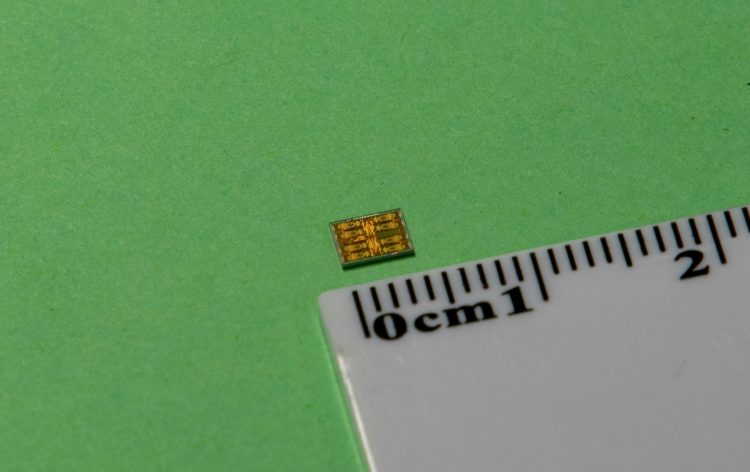Gearing up for 5G: A miniature, low-cost transceiver for fast, reliable communications

The proposed chip, fabricated in a standard 65-nanometer CMOS process, takes up a total area of just 12 mm2. Credit: Atsushi Shirane
A team of researchers led by Kenichi Okada at Tokyo Tech's Department of Electrical and Electronic Engineering has devised a strategy with a clear eye on supporting high-speed mobile data access using the millimeter-wave spectrum for 5G, the highly-anticipated wireless network of the near future.
Their proposed 28-GHz transceiver combines beamforming, a very efficient signal processing method, with dual-polarized MIMO capabilities, meaning that its array of antennas can respond to both horizontal and vertical radio waves at the same time.
Preliminary testing showed that the maximum data rate achieved was 15 gigabits per second (Gb/s) in the 64-QAM format. This data rate is 25 percent higher than that achieved by previous comparable models.
As a continuation of Okada and his group's work on developing top-level transceivers using minimal components, the researchers achieved a design that fits into an area measuring just 3 mm by 4 mm, which is around half the size achieved to date.
The smaller the chip, the better for 5G, owing to the anticipated demand for high-performance, area-efficient transceivers for use in tiny and portable sensors and devices.
“Compared with the conventional switch-based bi-directional approach, our bi-directional amplifier completely shares the inter-stage matching networks between the transceiver and the receiver. Thus, the required on-chip area is further minimized,” Okada explains.
Japan is currently stepping up efforts to prepare for 5G ahead of the Tokyo 2020 Olympic and Paralympic Games. There are big hopes for 5G services to enable higher data throughput for applications such as live-streaming high-definition (HD) video and for potentially trillions of new IoT devices that can share data around the clock, as well as to increase the speed and responsiveness of communication networks overall.
The research was partially supported by SCOPE, an initiative led by Japan's Ministry of Internal Affairs and Communications that focuses on promoting innovations in information and communication technologies.
Further details of the study are being presented as part of the 4G/5G Transceivers Session at the 2019 International Solid-State Circuits Conference (ISSCC) to be held in San Francisco from 17 to 21 February 2019.
###
Technical terms
[1] Beamforming: A signal processing technique that involves “pointing” antenna arrays in optimal directions.
[2] MIMO: A technology that utilizes multiple antennas at both ends of the transceiver (transmitter and receiver) to boost data rates.
Related links
New 28-GHz transceiver paves the way for future 5G devices https:/
Kenichi Okada – Wiring the world wirelessly | Tokyo Tech Research Story https:/
Media Contact
More Information:
https://www.titech.ac.jp/english/news/2019/043432.htmlAll latest news from the category: Information Technology
Here you can find a summary of innovations in the fields of information and data processing and up-to-date developments on IT equipment and hardware.
This area covers topics such as IT services, IT architectures, IT management and telecommunications.
Newest articles

NASA: Mystery of life’s handedness deepens
The mystery of why life uses molecules with specific orientations has deepened with a NASA-funded discovery that RNA — a key molecule thought to have potentially held the instructions for…

What are the effects of historic lithium mining on water quality?
Study reveals low levels of common contaminants but high levels of other elements in waters associated with an abandoned lithium mine. Lithium ore and mining waste from a historic lithium…

Quantum-inspired design boosts efficiency of heat-to-electricity conversion
Rice engineers take unconventional route to improving thermophotovoltaic systems. Researchers at Rice University have found a new way to improve a key element of thermophotovoltaic (TPV) systems, which convert heat…



